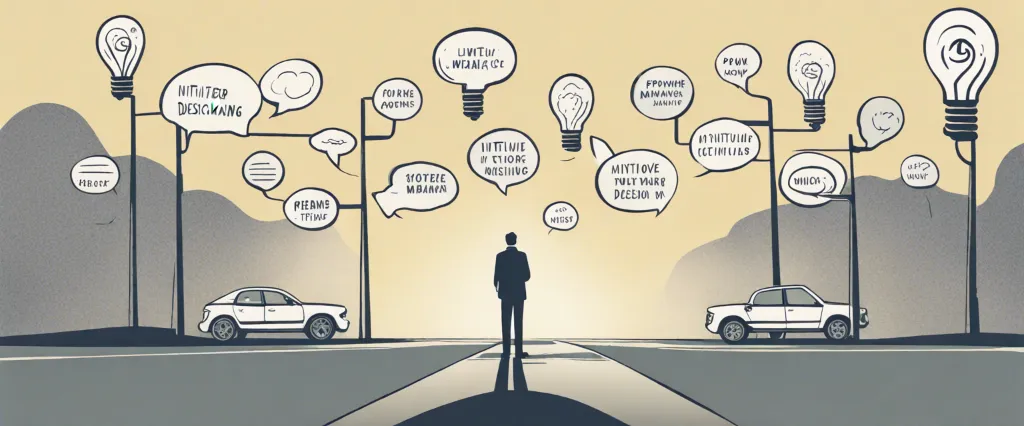In Sheena Iyengar’s thought-provoking book,The Art of Choosing by Sheena Iyengar readers are taken on an exploration of the intricate world of decision-making. Iyengar, a renowned social psychologist and expert in the field of choice, delves into the fascinating aspects of choice, its impact on our lives, and the factors that influence our decision-making processes. Drawing from her own experiences and extensive research, Iyengar unveils the art behind making choices and uncovers the extraordinary power that lies within our ability to choose.
Chapter 1: Exploring the complexities and psychology of decision-making
Chapter 1 of “The Art of Choosing” by Sheena Iyengar explores the intricate nature of decision-making and delves into the psychology behind it. The chapter begins by highlighting the importance of choices in our lives, emphasizing that every decision we make, no matter how trivial, reflects our identity and values.
Iyengar posits that decision-making is a complex process influenced by various factors such as cultural, social, and personal contexts. She discusses Barry Schwartz’s concept of the “paradox of choice,” suggesting that too many options can overwhelm individuals, leading to decision paralysis or dissatisfaction with the chosen outcome. On the contrary, limited choices may result in a lack of fulfillment due to a sense of missed opportunities.
The author highlights the cultural differences in decision-making, mentioning the influence of individualism versus collectivism. In individualistic societies, people often value personal choice and freedom, whereas collectivistic cultures may prioritize social harmony and the opinions of others.
Moreover, Iyengar considers the impact of different external factors on decision-making, such as the presentation of choices and how they are framed. For instance, the way products are displayed or information is structured can significantly influence our decisions.
Furthermore, the chapter explores the psychological aspects of decision-making, including the role of emotions and biases. Iyengar argues that emotions shape our decision-making process, sometimes leading to irrational or impulsive choices. Additionally, she highlights the presence of cognitive biases like confirmation bias, which influences our tendency to favor information that aligns with our preexisting beliefs.
In conclusion, Chapter 1 of “The Art of Choosing” presents an overview of the complexities and psychology of decision-making. It emphasizes the importance of understanding these factors to make informed choices that align with our values while acknowledging the impact of culture, external influences, emotions, and biases on decision-making processes.
Chapter 2: Understanding the influence of choice on our lives and happiness
Chapter 2 of “The Art of Choosing” by Sheena Iyengar explores the impact of choice on our lives and happiness. The chapter begins by highlighting the fact that people perceive choice as a fundamental aspect of freedom, autonomy, and individuality. However, it also emphasizes that too much choice can lead to decision-making paralysis and dissatisfaction.
Iyengar presents various studies and examples to illustrate these points. One study conducted in a supermarket demonstrated that when presented with a vast array of choices, customers were more likely to feel overwhelmed and less satisfied with their final selection. Moreover, research has shown that an excess of options can burden our cognitive resources, leading to decision fatigue and increased stress.
The concept of “maximizers” and “satisficers” is introduced to explain how individuals approach making choices. Maximizers tend to exhaustively examine all available options, seeking the best one, while satisficers set certain criteria and choose a satisfactory option that meets their requirements. Research suggests that satisficers are generally happier with their choices than maximizers, who are often plagued by regret and doubts about the options they didn’t select.
Iyengar also delves into the impact of cultural and societal influences on our decision-making. For instance, she discusses how individualistic cultures tend to prioritize personal choice and autonomy, while collectivist cultures may focus more on social harmony and fitting into predetermined roles.
Overall, Chapter 2 emphasizes the complexity of choice and highlights that while having options can enhance our well-being, excessive choices can have negative consequences. Finding a balance between the autonomy of choice and the limitations it can impose is crucial for living a satisfying and fulfilling life.
Chapter 3: Uncovering the factors that shape our preferences and desires
Chapter 3 of “The Art of Choosing” by Sheena Iyengar delves into the various factors that influence our preferences and desires. Iyengar argues that while choice is considered empowering, it is essential to understand the underlying forces that shape what we want and why we want it.
The chapter begins by exploring the concept of ‘default setting’ – the pre-established or suggested choices provided to us. These defaults significantly influence our decisions, as often we tend to stick with the default option, overcome by the cognitive effort required to evaluate alternate choices. Examples such as organ donation and retirement savings plans are used to emphasize how defaults can impact our preferences.
Next, Iyengar introduces the idea of ‘framing’ – the way in which information is presented to us. She highlights that the way choices are framed significantly alters our preferences and decisions. Positive frames, where the focus is on gains, tend to lead people towards risk aversion, while negative frames, with a focus on losses, push individuals towards risk-taking. The author also discusses the implications of framing on consumer behavior and decision-making.
Furthermore, Iyengar explores cultural influences on preferences. She emphasizes that culture plays a crucial role in shaping our desires and choices. Cultural norms, traditions, and socialization processes greatly impact what we find attractive or desirable. The chapter presents various studies and examples to support this claim, highlighting how our cultural upbringing influences our preferences in areas such as music, food, and even romantic partners.
Overall, Chapter 3 of “The Art of Choosing” sheds light on the factors that shape our preferences and desires. It underpins the significance of defaults, framing, and cultural influences in dictating our choices. Understanding these factors not only allows us to make more informed decisions but also empowers us to challenge and reconsider our preferences.
Chapter 4: Examining the role of culture and society in decision-making

Chapter 4 of “The Art of Choosing” by Sheena Iyengar focuses on the influence of culture and society in decision-making. The chapter examines how our cultural background and the societal values we adopt shape our choices.
Iyengar emphasizes that culture plays a significant role in influencing the way we perceive choice and make decisions. She argues that cultural norms determine what types of choices are considered acceptable or desirable in a particular society. For example, Western societies often prioritize personal autonomy and individualism, promoting a wide range of choices for individuals. In contrast, Eastern cultures tend to emphasize harmony and societal well-being, which may limit choices for the sake of maintaining social cohesion.
The author highlights the impact of societal norms in decision-making. These norms are the unwritten rules and expectations governing behavior within a society. They can influence the choices we make by creating social pressures or expectations. Iyengar explains how societal norms can affect a person’s decision to conform, deviate, or rebel against prescribed choices.
Culture and society also influence our preferences and biases. Iyengar provides examples of how people from different cultures may prioritize different aspects of decision-making, such as collectivism versus individualism, risk aversion, or the significance of social networks. These cultural preferences shape our decision-making processes and priorities.
Furthermore, the author explores how cultural and societal influences can sometimes lead to biased decision-making. People may favor choices that align with their cultural norms or conform to social expectations, even if those choices are not objectively the best option for them.
Overall, this chapter illustrates how culture and society act as powerful forces in shaping our decision-making processes. Understanding the influence of these factors can help individuals and organizations navigate the complexities of choice in diverse cultural contexts.
Chapter 5: Embracing the power of embracing and managing uncertainty
Chapter 5 of “The Art of Choosing” by Sheena Iyengar focuses on the concept of embracing and managing uncertainty. The chapter delves into how individuals make choices when faced with unpredictable situations and how they can better navigate through uncertainty.
Iyengar begins by highlighting how uncertainty affects decision-making. She explains that humans have an inherent desire for certainty and tend to gravitate towards options that provide clear outcomes. However, she argues that uncertainty can also offer opportunities for growth and innovation. To effectively embrace uncertainty, individuals must shift their mindset from fear and anxiety to curiosity and excitement.
The chapter emphasizes the importance of embracing ambiguity and ambiguity tolerance. Iyengar suggests that individuals who are willing to handle ambiguous situations tend to be more adaptable and resilient when faced with unexpected circumstances. She presents several strategies to enhance ambiguity tolerance, such as reframing uncertainty as a learning experience or seeking diverse perspectives to gain new insights.
Furthermore, Iyengar explores the role of information in managing uncertainty. She discusses how individuals gather and interpret information to make choices, highlighting the potential biases that can arise. It is crucial to acknowledge the limitations of available information and embrace a certain degree of uncertainty. By avoiding overconfidence and carefully weighing the available evidence, individuals can make more informed decisions in uncertain situations.
Ultimately, Iyengar emphasizes that embracing and managing uncertainty is an essential skill in decision-making. By adopting a flexible mindset, being open to ambiguity, and being aware of information biases, individuals can navigate uncertainty more effectively, leading to better choices and outcomes.
Chapter 6: Overcoming decision paralysis and analysis paralysis
Chapter 6 of “The Art of Choosing” by Sheena Iyengar focuses on the concepts of decision paralysis and analysis paralysis. Iyengar explains that decision paralysis occurs when individuals are faced with too many options, resulting in an overwhelming feeling that inhibits the ability to make a choice. Analysis paralysis, on the other hand, arises when individuals become overly fixated on gathering information and analyzing the available options, making it difficult to come to a decision.
To illustrate these concepts, Iyengar presents various studies and real-life examples. For instance, she mentions a study conducted by psychologists Mark Lepper and Sheena Lyengar, in which they found that individuals faced with a large selection of gourmet jams were less likely to make a purchase compared to those presented with a smaller selection. This demonstrates how too many options can trigger decision paralysis.
Furthermore, Iyengar discusses how analysis paralysis can hinder decision-making. She highlights the example of consumers spending an excessive amount of time researching products online or comparing different features, resulting in delayed choices or no decision at all.
To overcome decision and analysis paralysis, Iyengar suggests several strategies. One is setting personal goals or criteria to narrow down options, helping to prioritize and facilitate decision-making. Another approach is seeking advice or opinions from others to gain different perspectives and potentially simplify the decision-making process. Additionally, Iyengar emphasizes the importance of self-awareness to identify personal preference patterns and utilize them in decision making.
In conclusion, Chapter 6 of “The Art of Choosing” delves into the challenges of decision paralysis and analysis paralysis, while also offering strategies to overcome these obstacles. It underlines the significance of being aware of the impact of too many options or excessive analysis on decision-making and encourages readers to take proactive steps towards more efficient and effective choices.
Chapter 7: Harnessing the art of choosing to create a meaningful life
In Chapter 7 of “The Art of Choosing” by Sheena Iyengar, the focus is on how to harness the power of choice to create a meaningful life. Iyengar explores how our choices shape our identity, relationships, and overall well-being.
The chapter begins by emphasizing the importance of making choices that align with our values and aspirations. It suggests that being mindful of our preferences and values helps us make choices that are more meaningful and fulfilling. Additionally, Iyengar emphasizes that the process of choosing is just as important as the outcome. By actively participating in the decision-making process, individuals become more empowered and gain a sense of control over their lives.
The chapter also delves into the impact of external influences on our decision-making. Society, culture, and social norms can heavily influence our choices, often leading to conformity and a lack of authentic decision-making. However, Iyengar encourages readers to be aware of these external influences and to resist conformity when it contradicts their own desires and values.
Furthermore, the chapter discusses how our choices shape our relationships. Iyengar emphasizes the importance of making choices that promote connection, empathy, and understanding with others. Making choices that benefit both ourselves and others leads to stronger relationships and a greater sense of fulfillment.
Ultimately, Iyengar highlights the role of choice in creating a meaningful life. By consciously making choices that align with our values, resisting external pressures, and fostering positive relationships, individuals can craft a life that is both personally fulfilling and interconnected with others.

Chapter 8: Cultivating self-awareness and making choices aligned with our values
Chapter 8 of “The Art of Choosing” by Sheena Iyengar focuses on cultivating self-awareness and making choices that align with our values. The chapter emphasizes the importance of understanding our own preferences, values, and priorities in order to make choices that truly reflect who we are.
Iyengar begins by discussing the concept of self-awareness, which involves recognizing our own desires, beliefs, and motivations. She argues that in today’s world, we are bombarded with an overwhelming number of choices, making it crucial to develop a deep understanding of ourselves to navigate through these options effectively.
To cultivate self-awareness, Iyengar suggests engaging in introspection and reflection. This might involve identifying our core values, examining our past choices, and understanding the sources of influence in our lives. By understanding ourselves better, we become better equipped to make choices that bring us closer to our authentic selves.
The chapter also emphasizes the significance of aligning our choices with our values. Iyengar explains that when our choices go against our values, we may experience dissatisfaction and internal conflicts. To make choices in alignment with our values, she suggests defining our values clearly and then evaluating every choice against these values. This enables us to prioritize choices that contribute to our sense of purpose and fulfillment.
Moreover, Iyengar highlights the role of culture and social influences in shaping our values and choices. She encourages readers to critically examine societal norms and expectations, ensuring that their choices are not solely guided by external pressure.
Ultimately, the chapter serves as a reminder that self-awareness and values play a crucial role in making choices that bring us happiness and contentment. By understanding ourselves and aligning our choices with our values, we can lead more authentic and fulfilling lives.
After Reading
In “The Art of Choosing,” Sheena Iyengar delves into the fascinating world of decision making, offering valuable insights and strategies to navigate the complex web of choices that shape our lives. Through thorough research and personal anecdotes, Iyengar emphasizes the importance of actively participating in the decision-making process and understanding the various factors that influence our choices. Her extensive analysis of cultural, social, and psychological aspects of decision making sheds light on the intricate relationship between our choices and our overall well-being. Ultimately, Iyengar’s book serves as a powerful reminder to take control of our choices, embrace the freedom they bring, and consciously shape our lives.
1. Predictably Irrational: The Hidden Forces That Shape Our Decisions” by Dan Ariely – This book explores how our decisions are often influenced by irrational factors and provides insights into our decision-making processes.
2. Thinking, Fast and Slow” by Daniel Kahneman – Drawn from decades of research, this book delves into the two main systems of thinking that drive our choices and examines the biases and heuristics that impact our decision-making.
3. Nudge: Improving Decisions About Health, Wealth, and Happiness” by Richard H. Thaler and Cass R. Sunstein – Focusing on the concept of “nudging,” this book explores how small changes in our environment or the way choices are presented can significantly influence our decisions.
4. The Paradox of Choice: Why More Is Less” by Barry Schwartz – This book examines how an abundance of choices can sometimes lead to decision paralysis and explores strategies to overcome this paradox and find greater satisfaction in our decision-making.
5. Influence: The Psychology of Persuasion” by Robert B. Cialdini – This classic book uncovers the psychological principles and tactics employed by marketers, salespeople, and others to influence our decisions, helping readers become more aware and resilient to manipulation.




